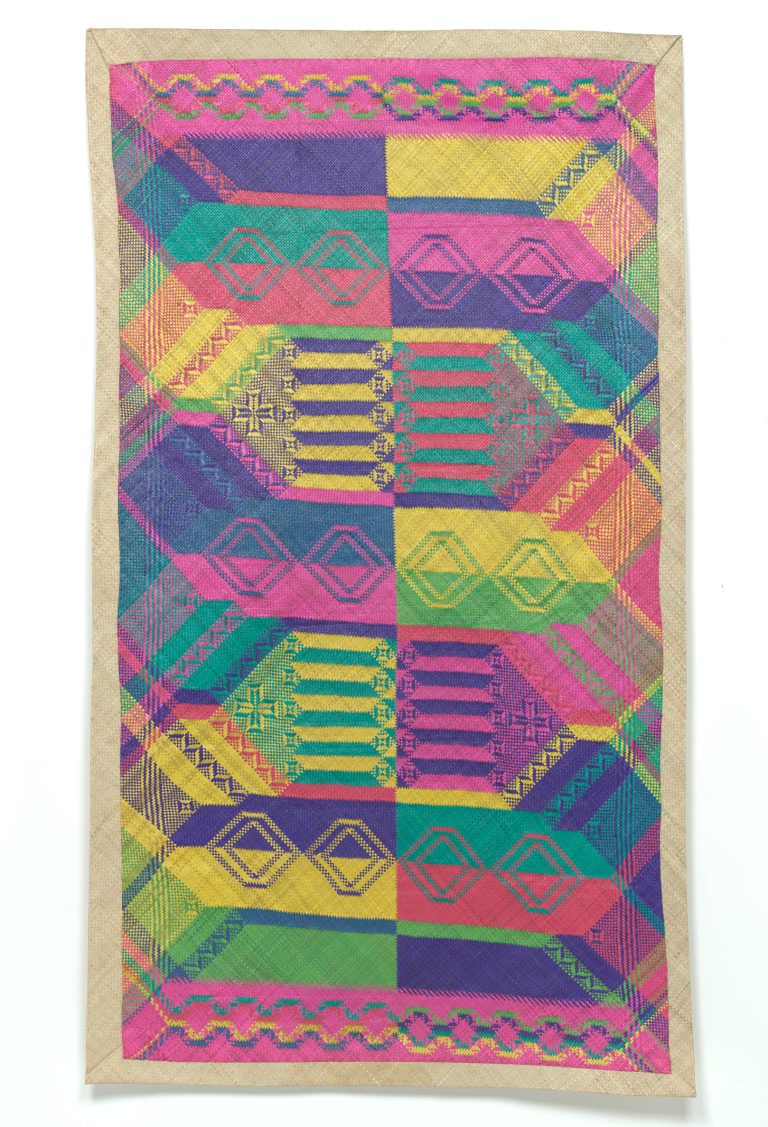We acknowledge the Traditional Owners of the land on which the Queensland Art Gallery | Gallery of Modern Art stands and recognise the creative contribution First Australians make to the art and culture of this country.

Norbaya Summalani / Bajau Sama Dilaut people / Malaysia b.c.1973 / Harunan Motol (Tangga Perahu) (Boat Ladder) 2019 / Woven pandanus, commercial chemical dye / 240 x 137cm / Purchased 2021 with funds from Ashby Utting Foundation through the QAGOMA Foundation / Collection: QAGOMA / © Norbaya Summalani
Bajau Sama Dilaut WeaversHarunan Motol (Tangga Perahu) (Boat Ladder) 2019
Not Currently on Display
Rectangular in format, the tepo (mats) of the Bajau Sama Dilaut are finely woven from pandanus leaves coloured with commercial dyes. Their colour range is particularly striking, with high-key pink, yellows and aquamarine set against deep greens and indigos.
Bound by neutral borders, they present bold geometric patterns, featuring motifs based on everyday life: intersecting angular waves represent the giant lobster prawn common in the region and the eyes of fishing hooks appear as loops while larger, elongated diamonds echo the flag sails raised during festive periods. Steps or ladders used to climb onto houseboats from dugouts appear as chains of alternating trapezoids in lighter or darker colours that create three-dimensional optical effects.
Designs from other familiar textiles also appear in the weaves. These include fine, checked arrangements known as ‘golden flowers’, drawn from handkerchiefs, and crisscrossing stripes of indigo and white from ancestral sarong patterns, in the popular South-East Asian style that inspired European gingham. Stacked flat bands of colour, meanwhile, take their inspiration from the timber floorboards on which the tepo are woven. There are even more patterns with more abstract sources, such as counting rhythms and oral instructions for weaving sequences of up, down, over and under. Different motifs are often combined in single tepo to produce designs of dazzling intricacy.
The Sama Dilaut (also known as Bajau, Bajau Laut and Sama Bajau) are an Austronesian ethnic group who live nomadic, seafaring lifestyles throughout the Indo-Malay and Philippine archipelagos, in particular eastern Borneo, Sulawesi and the islands of the Sulu and Celebes Seas.
The boldly coloured tepo (mats) made by the women of this community combine motifs passed down through generations, with geometric forms and imagery drawn from the Sama Dilaut’s maritime lifestyle. While the women’s creations have often been destined for the tourist market, they have more recently played a significant role in collaborations initiated by Sabahan artist Yee I-Lann, who has worked to introduce their tepo to regional art institutions and collectors. All proceeds are returned to the communities, and funds are managed by the women for local development initiatives.
The Bajau Sama Dilaut Weavers are Noraidah Jabarah, Kinnuhong Binti Gundasali, Makcik Lukkop Binti Belatan, Norbaya Summalani and Rahima Binti Jakarani.